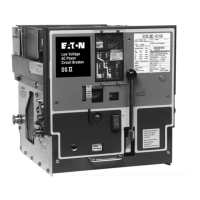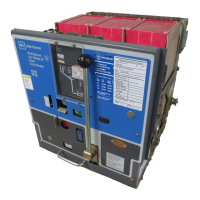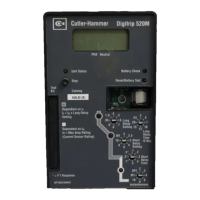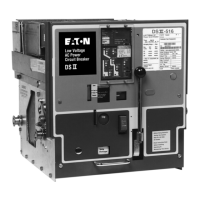I.
B.
694C694-02
SECTION 4: BASIC OPERATING
INSTRUCTIONS
A WARNING
WHEN CHARGING A CIRCUIT
BREAKER
ON ITS
COMPARTMENT EXTENSION RAILS OR ON A
WORKBENCH, HOLD IT TO PREVENT IT FROM
TILTING FORWARD AND POSSIBLY TOPPLING
TO
THE FLOOR CAUSING EQUIPMENT DAMAGE
AND/OR SERIOUS BODILY INJURY.
4-1
MANUAL
CIRCUIT
BREAKER
OPERATION
On manually operated circuit breakers, the closing
springs can only be charged by hand. The circuit break-
er
cannot be
in
the REMOVE position when manually
charging the springs. The design is such that the
springs will not be permitted to fully charge, before dis-
charging (trip-free close operation). If a circuit breaker
has been removed from its compartment to a remote
location for maintenance and charging of the closing
springs is required, the levering device arms on the
sides of the breaker must be rotated away from the
REMOVE position to the TEST position (Figure 2-4).
This is accomplished through the use of the levering
crank as described
in
paragraph 2-5.
When the circuit breaker is
in
the CONNECT
or
TEST
position as indicated on the front control panel indicator,
the closing springs can be charged by a single stroke
downward on the spring charging handle to a position
nearly 90 degrees from its normal upright rest position
(Figure 4-1). When the springs are charged, the handle
will suddenly become very easy to move, and a metallic
"click" will be heard as the over center closing springs
stop is reached. The spring charge indicator on the front
control panel will also indicate "Spring Charged."
A CAUTION
DO NOT RELEASE THE CHARGING HANDLE
BEFORE THE CHARGING OPERATION IS COMPLET-
ED. IF THE HANDLE IS RELEASED BEFORE THE
OPERATION IS COMPLETED, THE HANDLE
WILL
RETURN TO ITS NORMAL POSITION WITH A VELOC-
ITY GREAT ENOUGH TO
BREAK
THE CHARGING
HANDLE KNOB OR CAUSE BODILY INJURY.
Standard manually operated circuit breakers can only
be closed by hand using the close bar (Figure 3-3). An
Effective
07
/97
Page
23
optional closing spring release device can be supplied
for this same purpose. Refer to paragraph 3-10.2 for
additional information.
Standard manually operated circuit breakers can be
opened manually by using the trip plate on the front con-
trol panel or the trip plate
on
the compartment door.
Automatic opening of the circuit breaker can be accom-
plished through the use of several standard and/or
optional devices. Refer to paragraph 3-8.1 for details.
4-1.1 SPRING CHARGE MECHANISM FOR
MANUALLY
OPERATED
BREAKERS
The mechanism
in
a manually operated circuit breaker
is graphically illustrated
in
Figure 4-2. The actuator is
omitted for the sake of clarity.
Figure 4-3 shows details of the spring-charging device.
It is located between the mechanism right hand side
frame and the right crank arm. A part of this assembly is
the manual charge cam. It is rigidly fixed to the crank
shaft, the same as the main close cam and crank arms.
The other parts are the front crank assembly. It is pivot-
ed to a bracket fastened to the main frame base, and
has a socket for the manual charge handle. The rear
crank is pivoted to the front portion, and has a cross-
Figure 4-1 Manual Charging
of
Breaker Closing Springs
Courtesy of NationalSwitchgear.com

